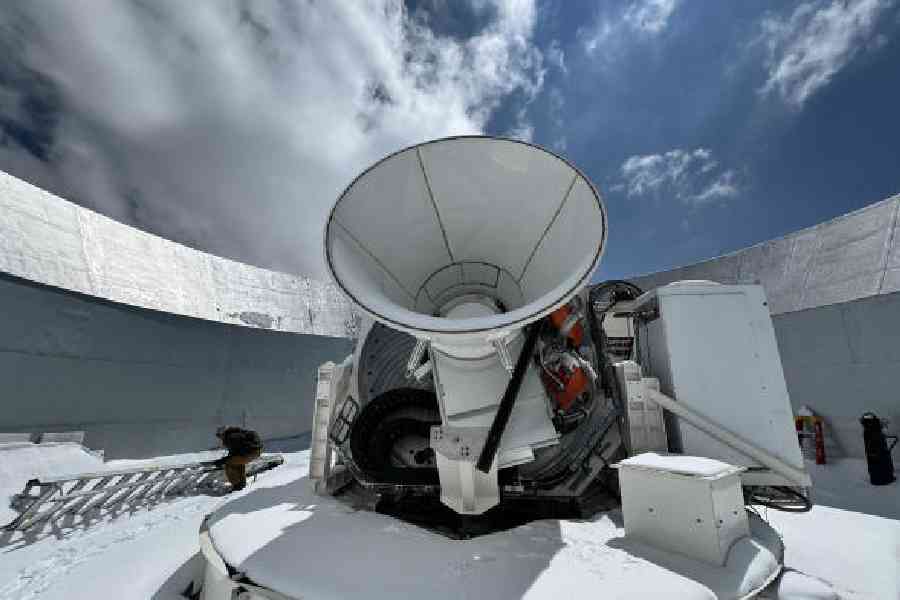The universe burst into existence 13.8 billion years ago. What happened in that earliest moment is of intense interest to anyone trying to understand why everything is the way it is today.
“I think this question of what happens at the beginning of the universe is a profound one,” said David Spergel, president of the Simons Foundation, a nonprofit organisation based in New York, US, that supports research at the frontiers of mathematics and science. “And what is remarkably exciting to me is the fact that we can do observations that can give us insight into this.”
A new $110 million observatory in the high desert of northern Chile, $90 million financed by the foundation, could uncover key clues about what happened after the Big Bang by looking at particles of light that have travelled across the universe since almost the beginning of time.
The data could finally provide compelling corroboration for a fantastical idea known as cosmic inflation. It holds that in the first sliver of time after the universe’s birth, the fabric of space-time accelerated outward to speeds far faster than the speed of light.
Alternatively, the observatory’s measurements could undercut this hypothesis, a pillar in the current understanding of cosmology.
The observatory is named after the foundation and its founders: Jim Simons, a hedge fund billionaire and philanthropist who died on May 10 this year, and his wife, Marilyn, a trained economist. Two of the four telescopes began taking measurements in April, in time for Simons’ 86th birthday on April 25.
“That was sort of the target that Jim set long ago for project completion,” Spergel said. “And we got there.”
Perched amid a majestically barren landscape at an altitude of 17,000 feet, the observatory has three small telescopes with a passing resemblance to ice cream cones and a larger one that consists of a pointable box, something that looks like a cousin to a Star Wars droid.
The telescopes gather microwaves — wavelengths longer than visible light but shorter than radio waves. Two of the smaller telescopes are gathering data. The third will join in a few months, and the fourth, much larger, will begin operations next year.
About 60,000 detectors in the four telescopes will then study a cosmic glow
of microwaves that fill the universe.
“It’s a unique instrument,” said Suzanne Staggs, a professor of physics at Princeton University, US, and co-director of the Simons Observatory. “We just have so, so many detectors.”
For the first 3,80,000 years of the universe’s infancy, temperatures were so high that hydrogen atoms could not form, and photons — particles of light — bounced off charged particles, continually absorbed and emitted. But as soon as hydrogen could form, the photons could travel unimpeded. The photons have cooled to just a few degrees above absolute zero, and their wavelengths have stretched into the microwave part of the spectrum.
The cosmic microwave background was first observed a half-century ago, a serendipitous hiss picked up by an antenna in Holmdel, New Jersey, US.
In the 1990s, a Nasa satellite, the Cosmic Background Explorer, revealed tiny temperature ripples within the cosmic microwaves — fingerprints pointing to what the early universe looked like. The fluctuations reflected variations in the universe’s density, and the denser regions would later coalesce into galaxies and even larger-scale structures of superclusters of galaxies, lining up like a cosmic
spider web.
The Simons Observatory aims to tease out yet more details — swirling patterns of polarised light that cosmologists call B-modes — in the microwaves.
Alan Guth, a professor at the Massachusetts Institute of Technology, US, proposed the idea of cosmic inflation 45 years ago, in part to explain the bland homogeneity of the universe. No matter in what direction you look, no matter how far out you look, everything in the cosmic microwave background looks pretty much the same.
But the observable universe is so large that there is not enough time for a photon to travel all the way across to equalise temperatures everywhere. But a rapid stretching of space-time — inflation — could have accomplished that, even though it would have ended when the universe was less than a trillionth of a billionth of a billionth of a second old.
Current cosmological observations fit with the cosmic inflation picture, said Brian Keating, a professor of physics at the University of California, US, and one of the leaders of the project.
But, Keating added, “To date, there’s no smoking gun.”
The accelerating expansion would have generated titanic gravitational waves that would have jostled matter in a way that would have imprinted B-modes among the primordial microwave radiation.
“The B-modes, these waves of gravity percolating throughout the cosmos, would be tantamount to the smoke from the gun,” Keating said.
For the B-modes, the scientists will examine a property of light known as polarisation.
Light consists of electric and magnetic fields that oscillate at right angles to each other. Usually, these fields are oriented in random directions, but when light reflects off certain surfaces, the fields can be knocked into alignment, or polarised.
The polarisation of light can be studied with a filter, through which only the part of the light polarised in a particular direction will pass.
The detectors at the observatory consist, in essence, of spinning polariser filters. If the microwaves were unpolarised, then the brightness of the microwaves would remain constant. If they are polarised, then the brightness will rise and fall — brightest when the filter aligns with the polarisation, dimmest when the filter is at a right angle to the polarisation.
Repeating that measurement across a swath of the sky will reveal the patterns of polarisations.
There are two types of polarisation patterns. One is called an E-mode, for electric, because it is the analogue of electric fields emanating from a charged particle. Previous microwave observations have detected E-modes in the primordial microwaves, generated by the variations in the universe’s density.
The other polarisation pattern possesses a characteristic found in magnetic fields. Because physics uses the letter B as the symbol to designate magnetic fields, it is known as the B-mode.
“They look like swirls,” Spergel said.
The gravitational waves would have shaken electrons in a way to generate tiny B-modes in the cosmic microwaves.
“Detection, that will be a Nobel Prize,” said Gregory Gabadadze, a professor of physics at New York University, US, and senior vice-president for physics at the Simons Foundation. “Never mind the Nobel Prize. The discovery of such a magnitude, who cares what prize you give it?”
NYTNS










